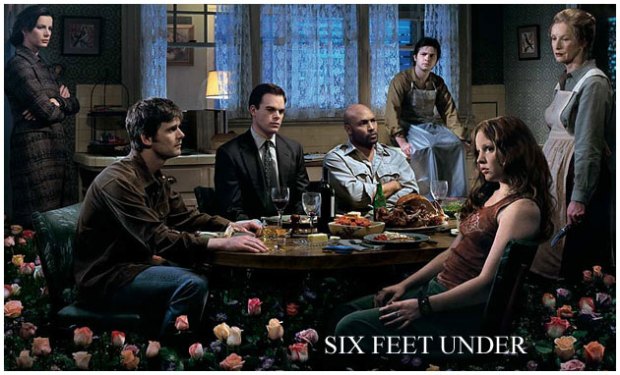When I first began watching HBO’s Six Feet Under the timing could not have been more profound. My grandmother had just died, and upon returning interstate from her funeral, I was informed via Facebook that a classmate of mine had just passed away. Two funerals, within two weeks… That is a little bit too close for comfort, even for those who are relatively comfortable with their own mortality.
Although I was prepared for the passing of my beloved Nan, I was caught off-guard by the unexpected death of a peer who was so young and as I thought, still had his whole life ahead of him.
From the very first episode, Alan Ball managed to captivate my intrigue by drawing back the curtain on the ‘taboo’ subject of grief, funerals and death. The show managed to provide me with a source of comfort at a time when I was feeling a little overwhelmed by life itself.
I hear you ask, “but how is a show about a dysfunctional family who run a funeral home an example of a mediated public sphere?” My answer to that lies within the documentary ‘Life and Loss: The Impact of Six Feet Under’.
McKee describes the public sphere as a metaphor used to explain how individuals come together to exchange opinions, feelings and information about what is important to them in a ‘liberal’ society. I would like to propose that Ball acts as the mediator in this example, by producing storylines that explore controversial themes such as homosexuality, religion, incest, and mortality.
‘Life and Loss’ explored the impact that Six Feet Under had, particularly amongst the embalming and funeral director community. Prior to the shows premier, when Daniel Biggins would discuss his occupation as a funeral director, he was often met with a disturbed expression. However, once Six Feet Under premiered, he was bombarded with hundreds of questions about his job, including: “have you watched the show?”
The show was praised by the funeral industry for accurately depicting the diversity of death rituals, ranging from Buddhist monks through to the funeral of a murderer. As a direct result of the show, there was an increase in organ donation and prearranged funerals, a clear indication that the show encouraged people to think about death.
Each episode would begin with a death; sometimes they were peaceful and other times they were sensationalised. One poignant example was the death of a baby to SIDS. The scene was depicted through the child’s perspective and was sensitively delivered. Ball fought hard to include this storyline as he felt that it was a reality of the industry and therefore needed to be covered, not just glossed over. As actress Lauren Ambrose explained, “I don’t believe audiences need to be sheltered from dark subject matter”.
The show was not made to be shocking, but rather to simply illustrate one of the two certainties of life, death and taxes.
References:
- antymon51. (2010). Life and Loss: The Impact of Six Feet Under. [Online Video]. 24 August 2010 Available from: https://www.youtube.com/watch?v=fzoIpasRAvI. [Accessed: 06 April 2014].
- HBO. 2001. Six Feet Under. [ONLINE] Available at: http://www.hbo.com/six-feet-under#/. [Accessed 06 April 14].
- IMDb. 2014. Alan Ball. [ONLINE] Available at: http://www.imdb.com/name/nm0050332/. [Accessed 06 April 14].
- IMDb. 2014. Lauren Ambrose. [ONLINE] Available at: http://www.imdb.com/name/nm0024404/. [Accessed 06 April 14].
- McKee, A, 2005, ‘Introduction: the public sphere : an introduction’ in Public Sphere: An Introduction, Cambridge University Press, Cambridge, pp1-31.
- Schiappa, Edward, 2004. AN A TELEVISION SERIES CHANGE ATTITUDES ABOUT DEATH? A STUDY OF COLLEGE STUDENTS AND SIX FEET UNDER. Death Studies, 28, 459-474.
- Image courtesy of HBO and Gif of gify



Hi April!
Ahh for the love of HBO. I love this post.
Brilliant fiction can make much more profound comments about society than a lot of other media sources because it can enable us to understand circumstances in a different light. Popular television, like Six Feet Under, can bring people together, and acts as a spring board for discussion and debate.
If I could give anyone advice on how to better their understanding of the interplay between our own personal lives and their socio-political context, I would tell them to not to bother studying Political Science, Law, or International Relations… I would tell them to plonk themselves on the couch and start watching The Wire.
Hey Camille!
How amazing is HBO? I have a bit of a love/hate relationship with it, as it manages to feed my habit of binge watching TV shows a little bit too much!
I could not agree with your opinion more about learning about the interplay between our personal lives and their socio-political contexts. I also agree that TV has the ability to help expose us to different perspectives, that perhaps otherwise we not have been. I love watching television and being exposed to worlds that are completely alien from my own. A particularly poignant example that comes to mind is the show ‘Big Love’ about a polygamous Mormon family. It is truly fascinating and I think you may enjoy it.
SFN was one the best US shows ever (in my top 5 list fo’ sho!)
Hey 🙂 I certainly agree with you!